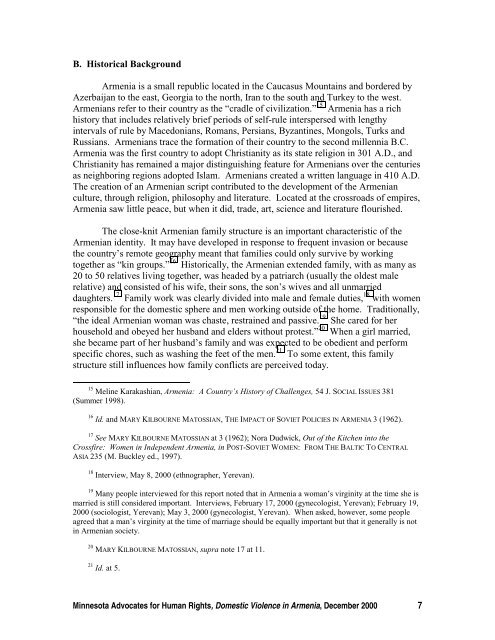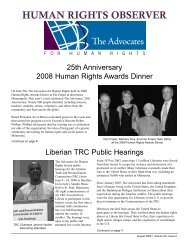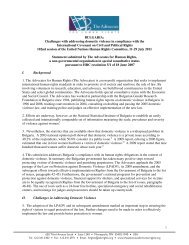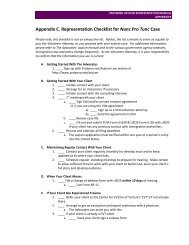Domestic Violence in Moldova - The Advocates for Human Rights
Domestic Violence in Moldova - The Advocates for Human Rights
Domestic Violence in Moldova - The Advocates for Human Rights
You also want an ePaper? Increase the reach of your titles
YUMPU automatically turns print PDFs into web optimized ePapers that Google loves.
B. Historical BackgroundArmenia is a small republic located <strong>in</strong> the Caucasus Mounta<strong>in</strong>s and bordered byAzerbaijan to the east, Georgia to the north, Iran to the south and Turkey to the west.Armenians refer to their country as the “cradle of civilization.” 15 Armenia has a richhistory that <strong>in</strong>cludes relatively brief periods of self-rule <strong>in</strong>terspersed with lengthy<strong>in</strong>tervals of rule by Macedonians, Romans, Persians, Byzant<strong>in</strong>es, Mongols, Turks andRussians. Armenians trace the <strong>for</strong>mation of their country to the second millennia B.C.Armenia was the first country to adopt Christianity as its state religion <strong>in</strong> 301 A.D., andChristianity has rema<strong>in</strong>ed a major dist<strong>in</strong>guish<strong>in</strong>g feature <strong>for</strong> Armenians over the centuriesas neighbor<strong>in</strong>g regions adopted Islam. Armenians created a written language <strong>in</strong> 410 A.D.<strong>The</strong> creation of an Armenian script contributed to the development of the Armenianculture, through religion, philosophy and literature. Located at the crossroads of empires,Armenia saw little peace, but when it did, trade, art, science and literature flourished.<strong>The</strong> close-knit Armenian family structure is an important characteristic of theArmenian identity. It may have developed <strong>in</strong> response to frequent <strong>in</strong>vasion or becausethe country’s remote geography meant that families could only survive by work<strong>in</strong>gtogether as “k<strong>in</strong> groups.” 16 Historically, the Armenian extended family, with as many as20 to 50 relatives liv<strong>in</strong>g together, was headed by a patriarch (usually the oldest malerelative) and consisted of his wife, their sons, the son’s wives and all unmarrieddaughters. 17 Family work was clearly divided <strong>in</strong>to male and female duties, 18 with womenresponsible <strong>for</strong> the domestic sphere and men work<strong>in</strong>g outside of the home. Traditionally,“the ideal Armenian woman was chaste, restra<strong>in</strong>ed and passive. 19 She cared <strong>for</strong> herhousehold and obeyed her husband and elders without protest.” 20 When a girl married,she became part of her husband’s family and was expected to be obedient and per<strong>for</strong>mspecific chores, such as wash<strong>in</strong>g the feet of the men. 21 To some extent, this familystructure still <strong>in</strong>fluences how family conflicts are perceived today.15 Mel<strong>in</strong>e Karakashian, Armenia: A Country’s History of Challenges, 54 J. SOCIAL ISSUES 381(Summer 1998).16 Id. and MARY KILBOURNE MATOSSIAN, THE IMPACT OF SOVIET POLICIES IN ARMENIA 3 (1962).17 See MARY KILBOURNE MATOSSIAN at 3 (1962); Nora Dudwick, Out of the Kitchen <strong>in</strong>to theCrossfire: Women <strong>in</strong> Independent Armenia, <strong>in</strong> POST-SOVIET WOMEN: FROM THE BALTIC TO CENTRALASIA 235 (M. Buckley ed., 1997).18 Interview, May 8, 2000 (ethnographer, Yerevan).19 Many people <strong>in</strong>terviewed <strong>for</strong> this report noted that <strong>in</strong> Armenia a woman’s virg<strong>in</strong>ity at the time she ismarried is still considered important. Interviews, February 17, 2000 (gynecologist, Yerevan); February 19,2000 (sociologist, Yerevan); May 3, 2000 (gynecologist, Yerevan). When asked, however, some peopleagreed that a man’s virg<strong>in</strong>ity at the time of marriage should be equally important but that it generally is not<strong>in</strong> Armenian society.20 MARY KILBOURNE MATOSSIAN, supra note 17 at 11.21 Id. at 5.M<strong>in</strong>nesota <strong>Advocates</strong> <strong>for</strong> <strong>Human</strong> <strong>Rights</strong>, <strong>Domestic</strong> <strong>Violence</strong> <strong>in</strong> Armenia, December 2000 7
















